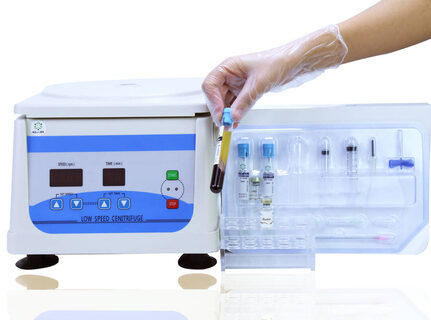Platelet-rich plasma (PRP) is a blood product that is commonly used in regenerative medicine, orthopedics, and other medical fields. PRP contains a high concentration of platelets, growth factors, and cytokines that can promote tissue healing and regeneration. One of the most critical steps in the preparation of PRP is centrifugation, which separates the blood components based on their density. However, some studies suggest that centrifugation can damage PRP and reduce its efficacy. In this blog, we will explore the question, “Is platelet-rich plasma damaged by centrifugation?”
How Does Centrifugation Affect PRP?
Centrifugation is an essential step in the preparation of PRP, as it separates the blood components based on their density. During the centrifugation process, the blood sample is spun at high speed, causing the heavier components, such as red blood cells and platelets, to settle to the bottom of the tube. The resulting PRP layer is then extracted from the tube and used for various medical procedures.
However, some studies suggest that centrifugation can damage PRP and reduce its efficacy. The high centrifugal forces can cause mechanical stress to the platelets, leading to their activation and release of growth factors. Additionally, the temperature and duration of centrifugation can also impact the quality of PRP.
Effects of Centrifugation Speed and Time on PRP
The speed and duration of centrifugation are critical factors that can affect the quality of PRP. Several studies have investigated the impact of centrifugation parameters on PRP and have reported varying results.
One study found that increasing the centrifugation speed from 1500g to 3000g resulted in a significant increase in platelet concentration but also led to a significant decrease in platelet activation and growth factor release. Another study reported that increasing the centrifugation time from 5 minutes to 20 minutes led to an increase in platelet concentration but also resulted in a decrease in platelet activation and growth factor release.
On the other hand, another study found that lower centrifugation speeds (1200g) and shorter durations (6 minutes) resulted in PRP with higher platelet concentrations, platelet activation, and growth factor release.
Overall, the optimal centrifugation parameters for PRP preparation may depend on the specific medical application and the patient’s needs.
Conclusion
In conclusion, centrifugation is a critical step in the preparation of PRP, but it can also impact the quality and efficacy of PRP. The centrifugation speed, duration, and temperature can affect the platelet concentration, activation, and growth factor release in PRP. Thus, it is essential to carefully consider these factors when preparing PRP and to tailor the preparation protocol to the specific medical application and patient needs. Further research is needed to fully understand the impact of centrifugation on PRP and to optimize its preparation for clinical use.








